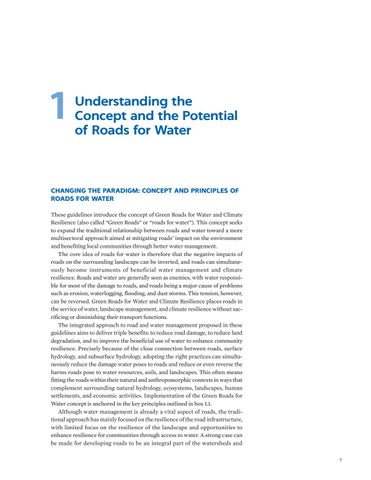1
Understanding the Concept and the Potential of Roads for Water
CHANGING THE PARADIGM: CONCEPT AND PRINCIPLES OF ROADS FOR WATER These guidelines introduce the concept of Green Roads for Water and Climate Resilience (also called “Green Roads” or “roads for water”). This concept seeks to expand the traditional relationship between roads and water toward a more multisectoral approach aimed at mitigating roads’ impact on the environment and benefiting local communities through better water management. The core idea of roads for water is therefore that the negative impacts of roads on the surrounding landscape can be inverted, and roads can simultaneously become instruments of beneficial water management and climate resilience. Roads and water are generally seen as enemies, with water responsible for most of the damage to roads, and roads being a major cause of problems such as erosion, waterlogging, flooding, and dust storms. This tension, however, can be reversed. Green Roads for Water and Climate Resilience places roads in the service of water, landscape management, and climate resilience without sacrificing or diminishing their transport functions. The integrated approach to road and water management proposed in these guidelines aims to deliver triple benefits: to reduce road damage, to reduce land degradation, and to improve the beneficial use of water to enhance community resilience. Precisely because of the close connection between roads, surface hydrology, and subsurface hydrology, adopting the right practices can simultaneously reduce the damage water poses to roads and reduce or even reverse the harms roads pose to water resources, soils, and landscapes. This often means fitting the roads within their natural and anthropomorphic contexts in ways that complement surrounding natural hydrology, ecosystems, landscapes, human settlements, and economic activities. Implementation of the Green Roads for Water concept is anchored in the key principles outlined in box 1.1. Although water management is already a vital aspect of roads, the traditional approach has mainly focused on the resilience of the road infrastructure, with limited focus on the resilience of the landscape and opportunities to enhance resilience for communities through access to water. A strong case can be made for developing roads to be an integral part of the watersheds and 7







































